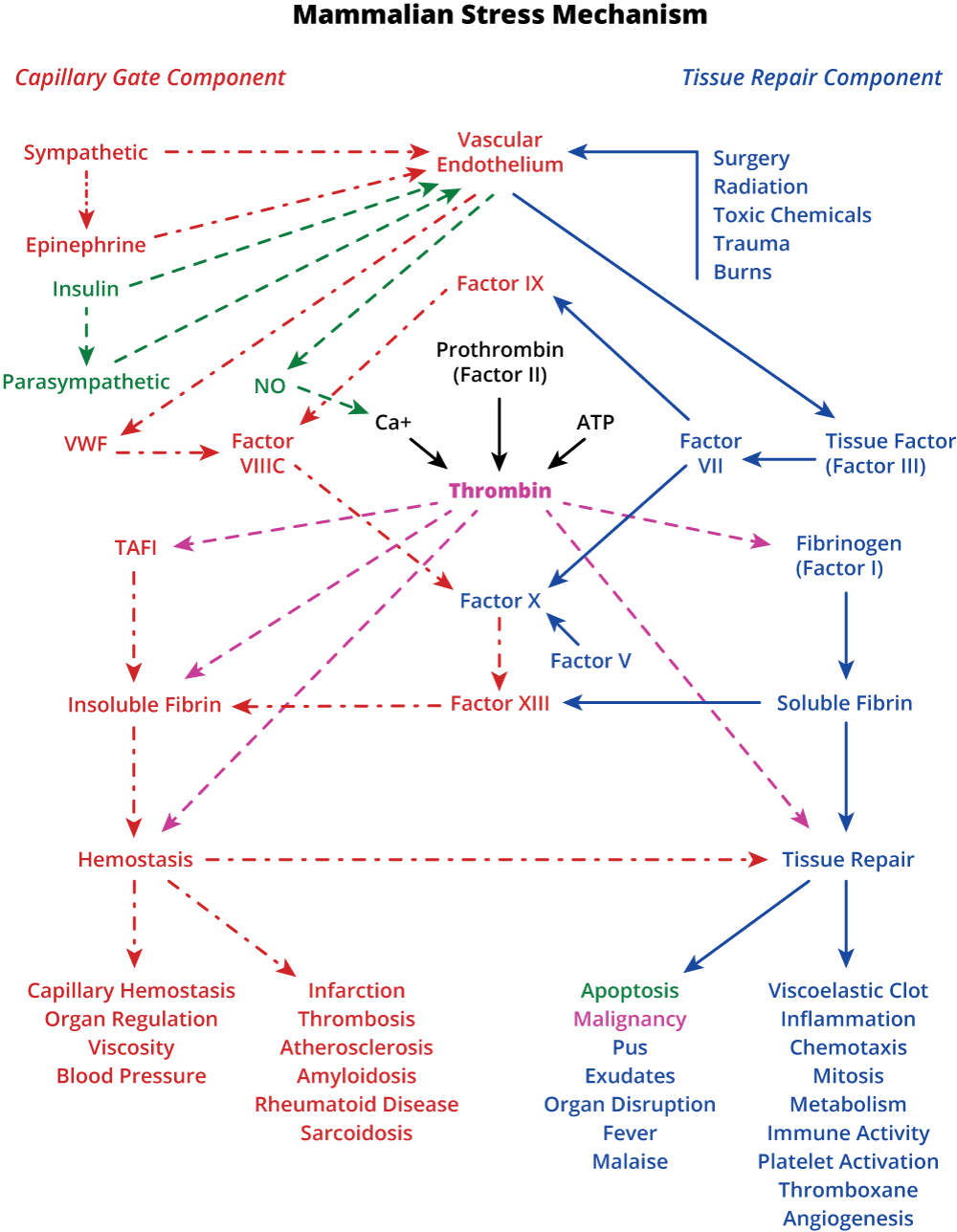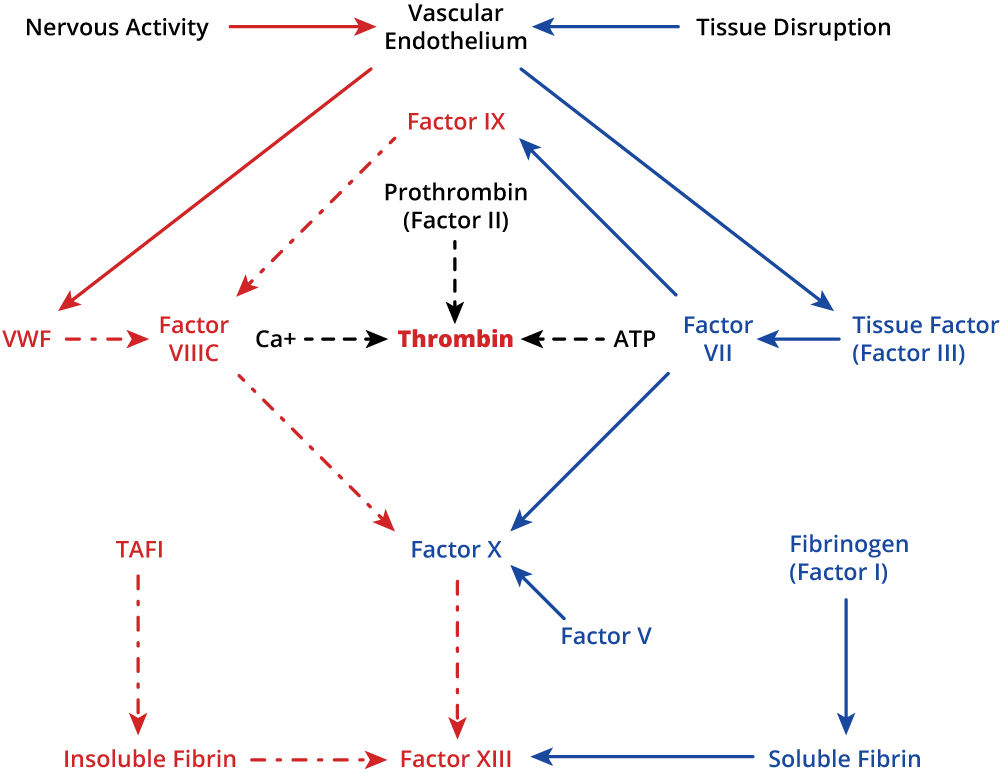What is stress theory?
Stress theory is a powerful medical theory that is closely associated with DNA theory. It postulates that a single “stress mechanism” enables embryological development and governs physiology, including breathing, blood flow, heart function, digestion, excretion, immune activity, hormone release, tissue maintenance, and tissue repair. Excessive and unremitting combinations of environmental stresses cause harmful stress mechanism hyperactivity that manifests as disease. Such stresses include fear, anxiety, trauma, surgery, excessive radiation, pesticides, herbicides, food additives, chlorinated water, automobile exhaust, industrial pollution, and bacterial and viral infections. Stress theory explains why diseases share similar symptoms such as fever, fatigue, inflammation, malaise, and hypercoagulability of blood. It also explains why seemingly unrelated diseases have compelling relationships. For example, diabetes, hypertension, obesity, heart disease, and cancer are all closely associated.
The Inspiration of Stress Research
Powerful scientific theories typically appear many years before accumulating evidence enables a testable mechanism that explains and confirms them, and that is the fate of stress theory. In 1869 Friedrich Miescher, a Swiss physician, theorized that DNA is the medium of genetic inheritance.(1) In 1925 a German researcher named Tannenberg proposed capillary gate theory, which later became part of stress theory.(2) In 1936 Hans Selye, a Hungarian physician, proposed stress theory.(3) All of these theories remained useless and unconfirmed for many years for lack of testable mechanisms that explained them.
In 1953 Watson and Crick discovered the testable DNA molecular structure that confirmed Miescher’s theory and explained how genetic information is retained and replicated.(4) Their unprecedented achievement happened soon after wartime research produced penicillin and polio vaccine, and it caused considerable excitement that is impossible to appreciate from our distant perspective. It seemed that medicine would soon conquer disease altogether. However, experts at the time realized that the DNA mechanism by itself does not explain how the DNA genetic blueprint is converted into embryological development, let alone explain the nature of physiology and disease. This focused scrutiny on Selye’s theory. It was widely believed that the hypothetical stress mechanism converts DNA genetic information into embryological development and then remains active for the duration of life to repair tissues and regulate physiology. Harmful hyperactivity of the stress mechanism, induced by environmental stresses, would theoretically explain the nature of disease. This would confer powerful new treatments that would revolutionize medicine. Many believed that very nature of life was at hand. These exciting prospects inspired an intense international search for the stress mechanism that lasted 30 years.
The Era of Stress Research
The stress researchers didn’t know what the stress mechanism looked like or how to search for it. They developed two seemingly unrelated concepts to facilitate their search. Capillary gate theory postulated the presence of a submicroscopic capillary gate mechanism that regulated blood flow resistance in the smallest of all blood vessels. This would theoretically confer an efficient and effective explanation of cardiac output, tissue perfusion, tissue oxygenation, and organ function. Tissue repair theory postulated the presence of a mechanism that controlled the orderly sequence of cellular activities that enabled tissue repair. Nobody believed that a single mechanism could possibly explain both tissue repair and blood flow regulation, so the stress researchers divided into two competing camps.
The era of stress research produced important advances in medical knowledge including immune theory, the coagulation cascade, and apoptosis, but it failed to find any clue of either a tissue repair mechanism or a capillary gate mechanism, let alone a single mechanism that could explain both. As a result, governments withdrew support for stress research and Selye’s ideas were relegated to the realm of the Unicorn. Nevertheless, stress theory was never disproved, and Selye’s ideas remained as virile as ever.
The Resurrection of Stress Theory
Genomics became the prevailing paradigm of medical research by default after stress research was abandoned. Genomics is founded on the “central dogma of molecular biology,” which assumes that each gene produces a unique protein that confers a specific biological effect. It further assumes that this simple mechanism governs physiology and causes disease. However, intense research has failed to find convincing evidence in support of these ideas, and there is growing frustration with the lack of theoretical advance in medicine and biology. Medical research has thus entered a period of crisis as described by Thomas Kuhn, and a new scientific paradigm is needed to restore research progress.(5, 6)
Meanwhile, fresh evidence from unrelated research has accumulated since stress research was abandoned. Finally, the Internet and advancing computer technology enabled an extensive review of published research that revealed the elusive stress mechanism in 2010.(7) Thus, just as Miescher’s DNA theory languished for 84 years until the DNA mechanism was discovered, Selye’s stress theory remained useless until the discovery of the mammalian stress mechanism 74 years later. Thus discovered, it incorporates both capillary gate theory and tissue repair theory, and fulfills all the predictions and expectations of the old stress researchers.
What is the stress mechanism?
The stress mechanism consists of:
- The entire nervous system
- Blood enzyme factors VII, VIII, IX and X that are continuously produced by the liver.
- The vascular endothelium, which is a delicate layer of specialized cells, one cell thick, that lines the inner surface of all blood vessels and is the sole constituent of capillaries, which are the smallest blood vessels. The vascular endothelium is innervated by the nervous system and it insulates the enzymes in flowing blood from extravascular tissues.
- “Tissue factor” that is produced by cells in extravascular tissues
The diagram below portrays the elements of the stress mechanism and their relationships.


Click here to download a detailed schematic of the stress mechanism.
How Does the Stress Mechanism Work?
The vascular endothelium isolates tissue factor from blood enzymes. Tissue damage (surgery, trauma, etc.) disrupts the vascular endothelium, which activates factor VII by exposing it to tissue factor. Factor VII activity determines the location and magnitude of tissue repair activity by initiating the enzymatic interaction of factors VII, VIII, IX and X.
The autonomic (subconscious) nervous system innervates the capillary vascular endothelium, so that autonomic balance (opposing effects of sympathetic and parasympathetic nervous activity) governs a “capillary gate mechanism” that regulates flow resistance in capillaries, which are the smallest blood vessels in the body. This determines cardiac output, cardiac efficiency, tissue perfusion, tissue oxygenation, blood pressure, heart rate, organ perfusion, organ function, and organ safety.
Obviously, the details of stress mechanism operation exceed the bounds of this website, but those interested can download free copies of my published papers and YouTube slide shows. In addition, I have published a book called “Fifty Years Lost in Medical Advance” that is available via Amazon. The book provides a detailed explanation of the stress mechanism and its ramifications, including a unified theory of medicine, a theory of anesthesia, analgesia and allostasis, and a unified theory of biology.
- R. Dahm, Friedrich Miescher and the discovery of DNA. Dev Biol 278, 274-288 (2005).
- J. Tannenberg, Uber die Kapillartatigkeit. Verh dtsch. path. Ges., 20:374, (1925).
- H. Selye, A Syndrome Produced by Diverse Nocuous Agents. Nature 138, 1 (1936).
- J. D. Watson, F. H. Crick, The structure of DNA. Cold Spring Harbor symposia on quantitative biology 18, 123-131 (1953).
- T. S. Kuhn, I. Hacking, The structure of scientific revolutions. (The University of Chicago Press, Chicago ; London, ed. Fourth edition., 2012), pp. xlvi, 217 p.
- J. Pontin, in Technology Review, J. Pontin, Ed. (MIT, MIT, 2010), vol. 114, chap. 8, pp. 1.
- L. S. Coleman, A Stress Repair Mechanism that Maintains Vertebrate Structure during Stress. Cardiovasc Hematol Disord Drug Targets, (2010).